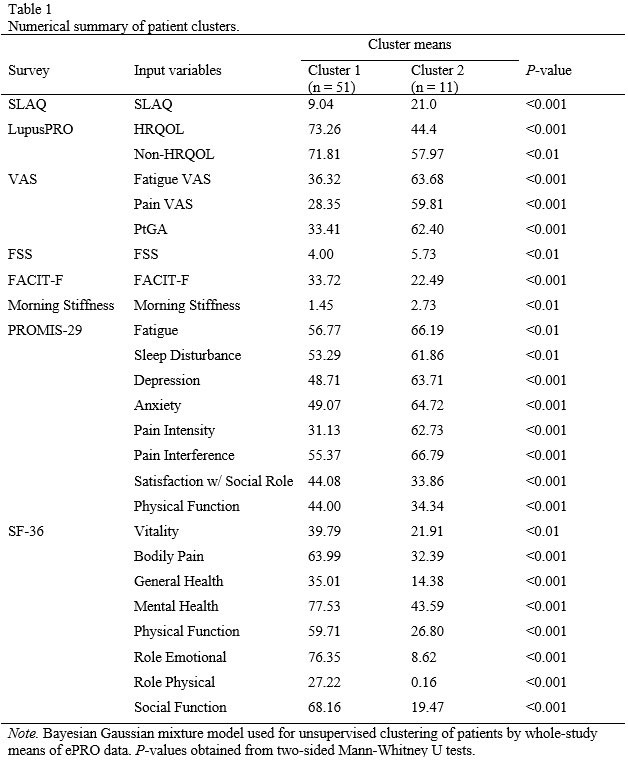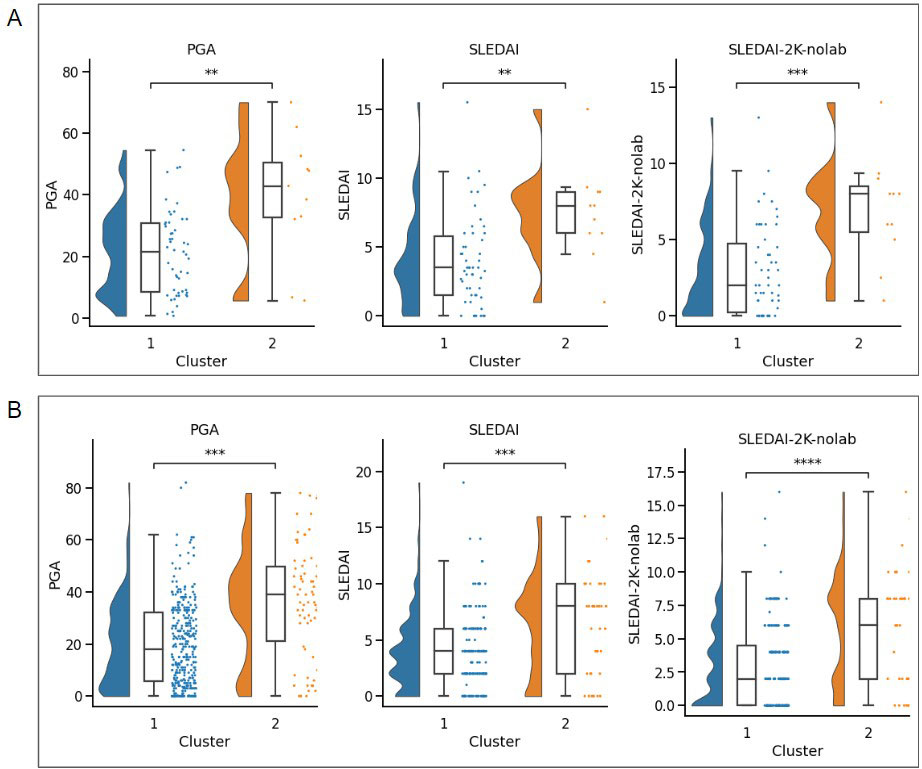Session Information
Date: Sunday, November 13, 2022
Title: SLE – Diagnosis, Manifestations, and Outcomes Poster II: Manifestations
Session Type: Poster Session C
Session Time: 1:00PM-3:00PM
Background/Purpose: Systemic lupus erythematosus (SLE) is an autoimmune disease with heterogeneous clinical presentations. Patient-reported outcomes (PROs) can aid in the measurement of the burden of disease. However, PRO information often does not correlate with physician-evaluated disease activity. This study employed unsupervised clustering analysis of PRO information from multiple instruments to identify subsets of patients with different levels of physician-evaluated disease activity.
Methods: The electronic PRO (ePRO) data of patients meeting the American College of Rheumatology (ACR) definition of SLE were collected over a period of 6 months as part of a multicenter clinical trial (NCT03098823). A smartphone application was developed to collect 10 separate PROs according to a schedule, collecting over 70,000 total records. A dataset containing the mean values of the PROs for each patient across the whole study was prepared. After preprocessing, unsupervised clustering analysis of the whole-study PRO means data was carried out. Three metrics of clustering performance were used to assess the best model and optimal number of clusters between Gaussian mixture modeling with variational inference, k-means clustering and hierarchical clustering. This analysis was repeated on a dataset of monthly PRO means where each mean was calculated from PROs recorded in the month preceding a clinic visit. Classification models were trained to distinguish cluster assignment in the monthly means dataset using a smaller subset of the PROs used as features for clustering. Model performance was assessed by area under the receiver operating characteristic curve (AUC).
Results: Clustering analysis of PRO information identified two groups from a diverse sample of 62 total SLE patients that differed in their symptoms as assessed by ePRO questionnaires. Cluster 1 contained 51 patients, whereas cluster 2 contained 11 patients; in general, cluster 1 patients reported significantly milder self-reported symptoms (Table 1). Notably, cluster 1 and 2 patients manifested significantly different SLEDAI as well as Physician Global Assessment scores (Figure 1A). These results were largely repeated in the clustering analysis of patients’ monthly PRO means, with a large, healthier cluster (n = 338) and a smaller cluster (n = 70) with more intense disease activity (Figures 1B and 2). A Support Vector Machine (SVM) classification model was able to classify patients into Group 1 or 2 reliably using only four PROs as input features, including measures of social functioning, Patient Global Assessment, pain intensity, and mental health. The model trained on these four features had a test set AUC of 0.98.
Conclusion: Two groups of SLE patients that differ significantly in physician measures of SLE activity were described by an unsupervised clustering analysis of ePROs collected using a novel smartphone application. Collection of ePRO data and patient cluster assignment based on those data could assist health care providers in monitoring SLE patients and personalizing their treatment.
To cite this abstract in AMA style:
Zent J, Bell K, Williams B, Bachali P, Lipsky P. Unsupervised Clustering of Lupus Patient-Reported Outcome Data Identifies Patient Groups with Differences in SLEDAI and Physician Global Assessment [abstract]. Arthritis Rheumatol. 2022; 74 (suppl 9). https://acrabstracts.org/abstract/unsupervised-clustering-of-lupus-patient-reported-outcome-data-identifies-patient-groups-with-differences-in-sledai-and-physician-global-assessment/. Accessed .« Back to ACR Convergence 2022
ACR Meeting Abstracts - https://acrabstracts.org/abstract/unsupervised-clustering-of-lupus-patient-reported-outcome-data-identifies-patient-groups-with-differences-in-sledai-and-physician-global-assessment/



